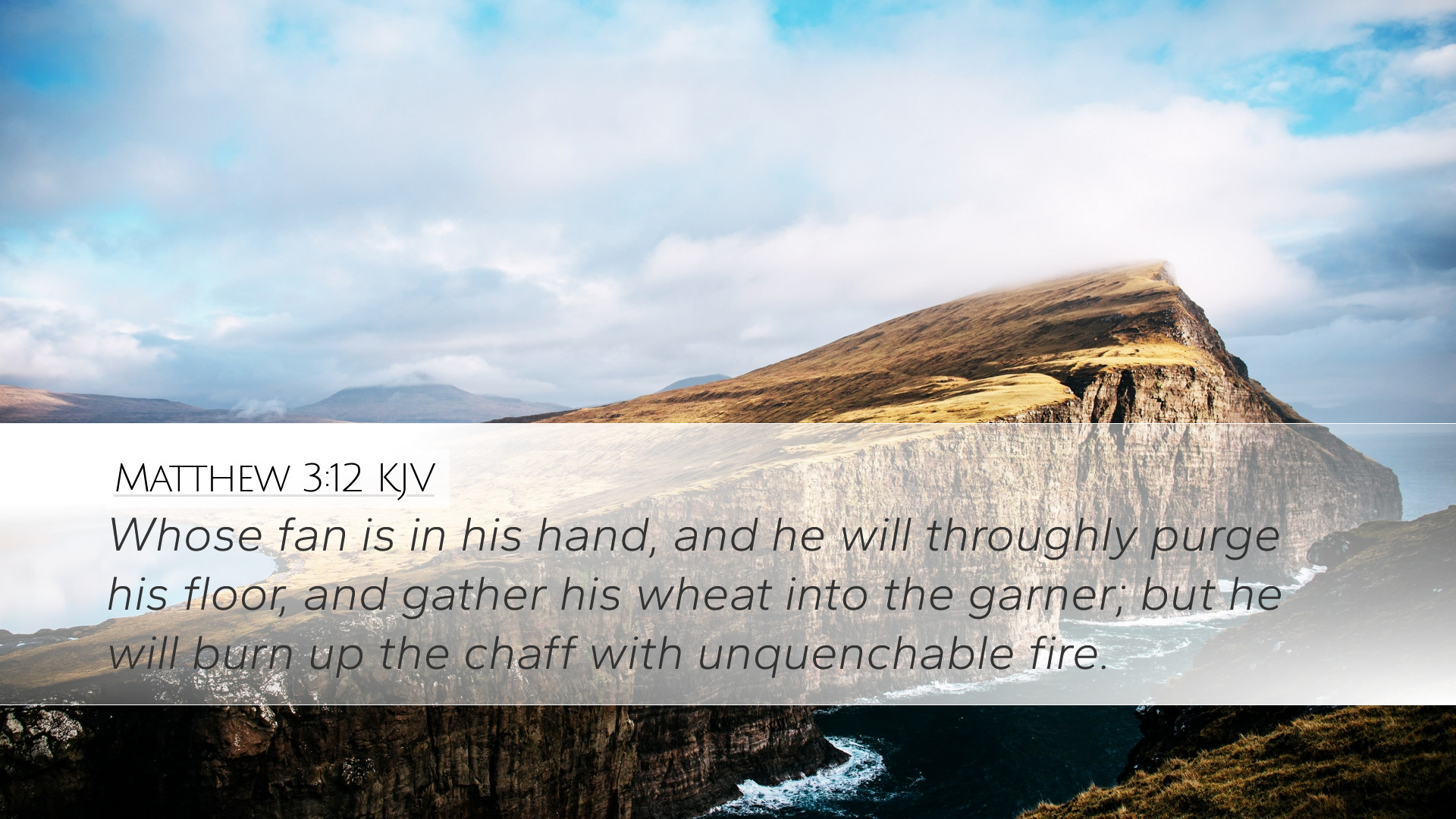Commentary on Matthew 3:12
Verse: "Whose fan is in his hand, and he will thoroughly purge his floor, and gather his wheat into the garner; but he will burn up the chaff with unquenchable fire." (Matthew 3:12)
This verse is a part of John's proclamation about the coming of Jesus Christ, the Messiah. Here, John the Baptist emphasizes the nature of Christ's work in the world, presenting a vivid depiction of judgment and separation.
Contextual Background
Before delving into the particulars of this verse, we must understand its context. John the Baptist played a pivotal role in preparing the way for Jesus. His message centered around repentance and the impending judgment. His preaching was a precursor to the ministry of Jesus, laying the foundation for the understanding of Jesus' mission.
Insights from Commentaries
-
Matthew Henry:
Henry interprets this verse as a profound illustration of the coming judgment. He highlights the distinction between the wheat and the chaff, symbolizing the righteous and the unrighteous. The 'fan' refers to a winnowing fork, a tool used to separate grain from the husks. This act of separation is indicative of Christ's ministry to sift through humanity, gathering the faithful while discarding those who remain unrepentant.
-
Albert Barnes:
Barnes focuses on the metaphor of the wheat and chaff to provide a deeper theological insight. He explains that the 'wheat' represents those who are genuinely converted, who will be placed in God's granary, a metaphor for heaven. Conversely, the 'chaff' symbolizes those who are unfruitful and unrepentant, destined for destruction. Barnes underscores the severity of Christ's judgment and the necessity of spiritual discernment.
-
Adam Clarke:
Clarke's commentary emphasizes the urgency of repentance in light of this judgment. He notes that the 'unquenchable fire' represents eternal punishment, reflecting Jesus' teaching about hell and its permanence. This reinforces the need for individuals to examine their lives and their standing before God. Clarke also discusses the symbolism of the 'fan' as a tool representing Christ's authority in administering judgment, distinguishing between those who are part of His kingdom and those who are not.
Symbolism of the Fan
The 'fan' serves as a powerful symbol of Christ's authority and the active role He plays in divine judgment. By using this agricultural metaphor, John the Baptist communicates the reality that Christ is intimately involved in the processes of sanctification and judgment. The act of fanning signifies the separation process that must occur as God evaluates the hearts of men.
Thorough Purging of the Floor
The phrase "thoroughly purge his floor" reflects a complete and meticulous judgment. This indicates that Christ will not overlook any detail; every individual's life will be scrutinized. True believers are gathered into safety, while the unrepentant are dealt with according to their deeds. This thoroughness of judgment is a crucial theme in biblical theology, echoing throughout both the Old and New Testaments.
Gathering of the Wheat
The gathering of the wheat into the garner signifies the redemption and safety of those who are righteous. This imagery invokes a sense of hope and assurance for believers, promising that they will be welcomed into God's eternal kingdom. It reinforces the idea that despite the trials and tribulations in this world, those who remain faithful will ultimately receive their reward.
Destruction of the Chaff
In contrast, the burning of the chaff reveals the grave consequences of rejecting God's offer of grace. This is not merely a warning but a reality check for those who might think they can remain indifferent toward God. The unquenchable fire speaks to the eternal nature of this judgment, reinforcing the urgency of repentance and faith in Christ.
Application for Today
For pastors, students, theologians, and Bible scholars, this verse serves as a poignant reminder of the centrality of repentance and the reality of divine judgment. It challenges the complacency that can often seep into our spiritual lives. The severe imagery calls for a profound response from believers to maintain their faith and pursue holiness. It also necessitates clarity in teaching the doctrines of grace and judgment, emphasizing the importance of leading others toward the path of righteousness.
Conclusion
Matthew 3:12 encapsulates vital truths about the nature of Jesus' ministry and the realities of judgment. As we reflect on this verse, we are reminded of our responsibilities as followers of Christ—to pursue holiness, to preach repentance, and to bear witness to the hope found in the gospel. The imagery of the wheat and chaff compels us to examine both our own hearts and those of others, urging us to engage in the ministry of reconciliation with urgency and compassion.


